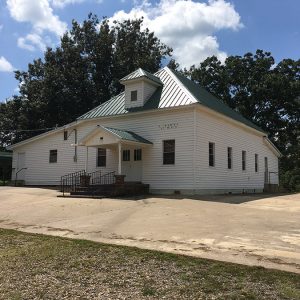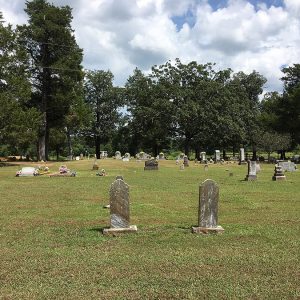calsfoundation@cals.org
Green Ridge (Scott County)
Green Ridge is an unincorporated community located in east-central Scott County along Highway 248. Green Ridge was established in 1872 near Prairie Creek. Agriculture and religion have traditionally been important to Green Ridge’s culture and economy.
Prior to European exploration, Green Ridge was a wilderness lush with native vegetation and numerous species of wildlife—including buffalo and elk, which no longer inhabit the area. Archaeological evidence from the Archaic, Woodland, and Mississippian periods has been discovered along the Poteau River to the south. Additional archaeological evidence has indicated that the Caddo tribe had a strong presence along the Poteau River and other prominent waterways.
Spanish explorer Hernando De Soto is credited with being the first European to explore the territory around Green Ridge, although there is no evidence to support this claim. Throughout the late seventeenth and early eighteenth centuries, French trappers and traders traveling west from the Arkansas Post likely traversed the Poteau River and other bodies of water in the area.
White settlers began arriving in the area near Green Ridge as early as the late 1820s. The area continued to be settled from the 1830s to the 1880s. Most families participated in a wide variety of agricultural practices.
The Civil War affected people living in the area near Green Ridge as it did throughout the rest of the Confederacy. Men who were called to fight in the war served with both the Confederacy and Union. The women, children, and the elderly were left to look after the homes and farms.
After the Civil War, there was an influx of settlers to Scott County, including Green Ridge. Pleasant Grove Cemetery Number 3 was established in 1871 just north of Green Ridge. South of Green Ridge is also Pilot Prairie Cemetery, which was established circa 1867.
Green Ridge Post office was established in April 1872 with Robert B. Featherston as the first postmaster. Green Ridge became a more established community after Reconstruction. It is unclear, though, as to how Green Ridge got its name. A third small cemetery was established in Green Ridge circa 1881 and named Liberty Cemetery.
In May 1882, the Scott County Courthouse burned, destroying all records that defined the boundaries of the various school districts that had been established throughout the county. Several months later, in August, the county court reestablished the boundaries of the fifty-six school districts active in the county, including Green Ridge School District (Number 10). The Green Ridge School House was located west of Mount Pleasant Church. The school faced the church and was white clapboard with a small belfry containing a large iron bell. The floorboards inside were made from native pine. Coal and wood stoves were used to heat the school house in winter. The school house was sold and moved to the Stamps family farm in the early 1950s. The building was used a dwelling for many years.
Religious activities were popular among residents of Scott County in the late nineteenth century. In 1889, a church picnic was held at Green Ridge that attracted many residents from the area. Members of the Green Ridge, Pilot Prairie, Lone Star, and Mount Pleasant school districts were in attendance at the picnic and sang gospel songs. The picnic continued into the evening and provided supper and additional singing.
The community had a general store, blacksmith shop, and several different mills. A large, three-story mill was located a quarter mile north of the current Mount Pleasant Church. Alvin Self, Frank Bottoms, and a Mr. Brown were the owners and operators of the mill circa 1904. The full time workforce of the mill was eight to ten men.
The Green Ridge Post Office was discontinued in 1938, with mail sent to Waldron (Scott County). During the Great Depression, many farmers in the area faced economic distress, with the price of cotton and other crops having dropped significantly.
Several members of the Green Ridge community served during World War II. Green Ridge School District was consolidated with Waldron sometime between 1945 and 1954. Green Ridge declined significantly with the loss of the school.
The Pleasant Grove Baptist and Pilot Prairie Presbyterian churches are still located in Green Ridge in the twenty-first century. A small park known as Rainbow Park was built by the congregation at Pleasant Grove Baptist Church in memory of Chase Bates, who died in 2006. The park is located on the grounds of the church and cemetery. Waldron City Lake and Langston Lake are located just north of Green Ridge and serve as recreational areas. Agriculture continues to be an important way of life in Green Ridge, mostly in the form of cattle and chicken farms.
For additional information:
Biographical and Historical Memoirs of Western Arkansas. Chicago: Goodspeed Publishing Company, 1891.
Cate, Michael. History of Scott County, Arkansas. Dallas: Curtis Media Corporation, 1991.
Goodner, Norman. A History of Scott County, Arkansas. Siloam Springs, AR: Bar D Press, 1941.
McCutcheon, Henry Grady. History of Scott County, Arkansas. Little Rock: H. G. Pugh and Company, 1922.
Ty Richardson
Richardson Preservation Consulting
 Pleasant Grove Baptist Church
Pleasant Grove Baptist Church  Pleasant Grove Cemetery
Pleasant Grove Cemetery  Rainbow Park
Rainbow Park  Scott County Map
Scott County Map 



Comments
No comments on this entry yet.